
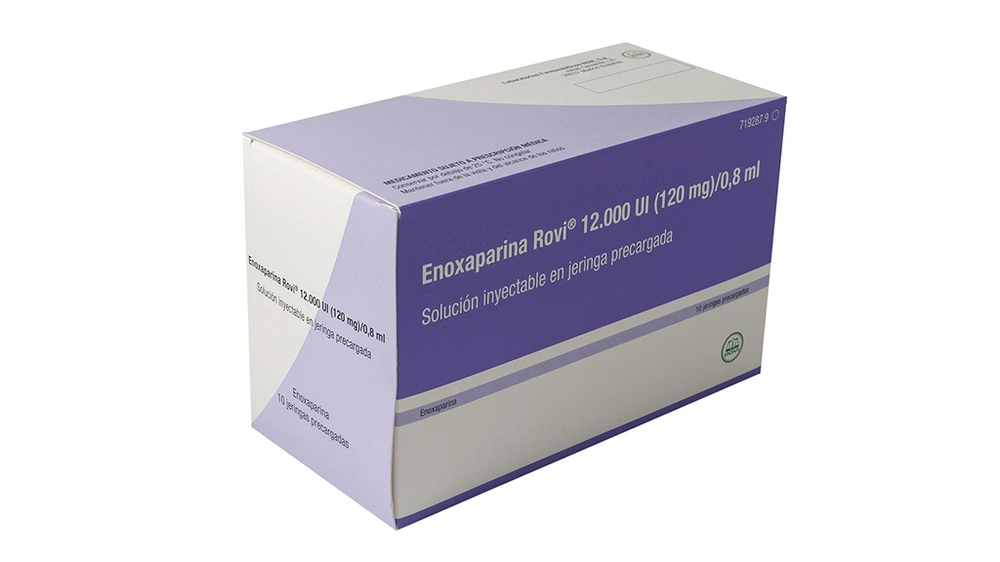
ENOXAPARIN ROVI 12,000 IU (120 mg)/0.8 mL PRE-FILLED SYRINGE SOLUTION FOR INJECTION


How to use ENOXAPARIN ROVI 12,000 IU (120 mg)/0.8 mL PRE-FILLED SYRINGE SOLUTION FOR INJECTION
Introduction
Package Leaflet: Information for the User
Enoxaparina Rovi 12,000 IU (120 mg)/0.8 ml Solution for Injection in Pre-filled Syringe
enoxaparina sodium
Read all of this leaflet carefully before you start using this medicine because it contains important information for you.
- Keep this leaflet, you may need to read it again.
- If you have any further questions, ask your doctor, pharmacist, or nurse.
- This medicine has been prescribed for you only. Do not pass it on to others. It may harm them, even if their signs of illness are the same as yours.
- If you get any side effects, talk to your doctor or pharmacist. This includes any possible side effects not listed in this leaflet. See section 4.
Contents of the Pack
- What Enoxaparina Rovi is and what it is used for
- What you need to know before you use Enoxaparina Rovi
- How to use Enoxaparina Rovi
- Possible side effects
- Storage of Enoxaparina Rovi
- Contents of the pack and other information
1. What Enoxaparina Rovi is and what it is used for
Enoxaparina Rovi contains the active substance enoxaparin sodium, which is a low molecular weight heparin (LMWH).
Enoxaparina Rovi works in two ways:
- Preventing existing blood clots from getting bigger. This helps your body to break them down and stop them from causing harm.
- Stopping new blood clots from forming.
Enoxaparina Rovi can be used to:
- Treat blood clots.
- Prevent blood clots from forming in the following situations:
- Before and after surgery.
- When you have an acute illness and are about to undergo a period of reduced mobility.
- If you have had a blood clot due to cancer, to prevent more clots from forming.
- When you have unstable angina (a condition where not enough blood reaches the heart).
- After a heart attack.
- Prevent blood clots from forming in the tubes of a dialysis machine (used in people with severe kidney problems).
2. What you need to know before you use Enoxaparina Rovi
Do not use Enoxaparina Rovi
- If you are allergic to enoxaparin sodium or any of the other ingredients of this medicine (listed in section 6). The signs of an allergic reaction include: rash, problems swallowing or breathing, swelling of the lips, face, throat, or tongue.
- If you are allergic to heparin or other low molecular weight heparins, such as nadroparin, tinzaparin, or dalteparin.
- If you have had a reaction to heparin that caused a severe decrease in the number of cells involved in blood clotting (platelets) - this reaction is called heparin-induced thrombocytopenia - in the last 100 days or if you have antibodies against enoxaparin in your blood.
- If you are bleeding heavily or have a high risk of bleeding (such as stomach ulcers, recent eye or brain surgery), including recent hemorrhagic stroke.
- If you are using Enoxaparina Rovi to treat blood clots and are going to have spinal or epidural anesthesia or a lumbar puncture within 24 hours.
Warnings and Precautions
Enoxaparina Rovi should not be exchanged with other low molecular weight heparin medicines. This is because they are not exactly the same and do not have the same activity or instructions for use.
Consult your doctor or pharmacist before starting to use Enoxaparina Rovi if:
- you have ever had a reaction to heparin that caused a severe decrease in the number of platelets
- you are going to have spinal or lumbar anesthesia or a lumbar puncture (see "Surgical Operations and Anesthesia"): a delay must be observed between Enoxaparina Rovi and the use of this procedure
- you have had a heart valve implanted
- you have endocarditis (an infection of the inner lining of the heart)
- you have a history of stomach ulcers
- you have recently had a stroke
- you have high blood pressure
- you have diabetes or problems with the blood vessels in your eyes caused by diabetes (called diabetic retinopathy)
- you have recently had eye or brain surgery
- you are an elderly person (over 65 years old) and especially if you are over 75 years old
- you have kidney problems
- you have liver problems
- you are underweight or overweight
- you have high levels of potassium in your blood (which could be checked with a blood test)
- you are currently using medicines that affect bleeding (see below - Use of Enoxaparina Rovi with other medicines).
You may need to have a blood test before starting to use this medicine and while you are using it; this is to check the level of cells involved in blood clotting (platelets) and the levels of potassium in your blood.
Children and Adolescents
The safety and efficacy of enoxaparin in children and adolescents have not been established.
Use of Enoxaparina Rovi with other medicines
Tell your doctor or pharmacist if you are using, have recently used, or might use any other medicines.
- Warfarin - used to reduce blood clotting
- Aspirin (also known as acetylsalicylic acid or ASA), clopidogrel, or other medicines used to prevent blood clots from forming (see also section 3, "Change of anticoagulant treatment")
- Dextran injection - used as a blood substitute
- Ibuprofen, diclofenac, ketorolac, and other non-steroidal anti-inflammatory medicines used to treat pain and inflammation in arthritis and other diseases
- Prednisolone, dexamethasone, and other medicines used to treat asthma, rheumatoid arthritis, and other diseases
- Medicines that increase the level of potassium in your blood, such as potassium salts, diuretics, and some medicines used to treat heart problems.
Surgical Operations and Anesthesia
If you are going to have a lumbar puncture or are going to undergo surgery where spinal or epidural anesthesia is used, inform your doctor that you are using Enoxaparina Rovi. See "Use of Enoxaparina Rovi with other medicines". Also, inform your doctor if you have any problems with your spine or if you have ever had spinal surgery.
Pregnancy and Breastfeeding
If you are pregnant, think you may be pregnant, or are planning to become pregnant, consult your doctor or pharmacist before using this medicine.
If you are pregnant and have a mechanical heart valve, you may be at higher risk of blood clots. Your doctor will discuss this with you.
If you are breastfeeding or plan to breastfeed, you must consult your doctor before using this medicine.
Driving and Using Machines
Enoxaparina Rovi does not affect your ability to drive or use machines.
It is recommended that your healthcare professional record the trade name and batch number of the product you are using.
Enoxaparina Rovi contains sodium
This medicine contains less than 23 mg of sodium (1 mmol) per dose; this is essentially "sodium-free".
3. How to use Enoxaparina Rovi
Follow the administration instructions for this medication exactly as indicated by your doctor or pharmacist. In case of doubt, consult your doctor or pharmacist again.
Using the medication
- Normally, your doctor or nurse will administer Enoxaparina Rovi to you. This is because it must be administered by injection.
- When you return home, you may need to continue using Enoxaparina Rovi and administer it yourself (see the instructions on how to do it).
- Enoxaparina Rovi is usually administered by injection under the skin (subcutaneously).
- Enoxaparina Rovi can be administered by injection into your veins (intravenously) after certain types of heart attacks and surgical operations.
- Enoxaparina Rovi can be added to the tube that comes out of the body (arterial line) at the beginning of the dialysis session.
Do not administer Enoxaparina Rovi into a muscle (intramuscularly).
How much will be administered to you
- Your doctor will decide the amount of Enoxaparina Rovi to be administered to you. The amount will depend on the reason for its use.
- If you have kidney problems, you may be administered a smaller amount of Enoxaparina Rovi.
- Treatment of blood clot formation:
- The usual dose is 150 IU (1.5 mg) per kilogram of body weight per day or 100 IU (1 mg) per kilogram of body weight twice a day.
- Your doctor will decide how long you will receive Enoxaparina Rovi.
- Prevention of blood clot formation in the following situations:
Surgery or periods of limited mobility due to illness
- The dose will depend on your likelihood of developing a clot. You will be administered 2,000 IU (20 mg) or 4,000 IU (40 mg) of Enoxaparina Rovi per day.
- If you are going to have surgery, you will usually be given the first injection 2 or 12 hours before the operation.
- If you have reduced mobility due to illness, you will usually be administered 4,000 IU (40 mg) of Enoxaparina Rovi per day.
- Your doctor will decide how long you will receive Enoxaparina Rovi.
After having a heart attack
Enoxaparina Rovi can be used in 2 different types of heart attacks, called STEMI (ST-elevation myocardial infarction) or non-STEMI. The amount of Enoxaparina Rovi administered to you will depend on your age and the type of heart attack you had.
Non-STEMI heart attack:
- The usual dose is 100 IU (1 mg) per kilogram of body weight every 12 hours.
- Usually, your doctor will tell you to also take aspirin (acetylsalicylic acid).
- Your doctor will decide how long you will receive Enoxaparina Rovi.
STEMI heart attack if you are under 75 years old:
- You will be administered an initial intravenous injection of 3,000 IU (30 mg) of Enoxaparina Rovi.
- At the same time, you will be administered a subcutaneous injection of Enoxaparina Rovi. The usual dose is 100 IU (1 mg) per kilogram of body weight every 12 hours.
- Usually, your doctor will tell you to also take aspirin (acetylsalicylic acid).
- Your doctor will decide how long you will receive Enoxaparina Rovi.
STEMI heart attack if you are 75 years old or older:
- The usual dose is 75 IU (0.75 mg) per kilogram of body weight every 12 hours.
- The maximum amount of Enoxaparina Rovi administered in the first two injections is 7,500 IU (75 mg).
- Your doctor will decide how long you will receive Enoxaparina Rovi.
For patients undergoing percutaneous coronary intervention (PCI):
Depending on when you last received an injection of Enoxaparina Rovi, your doctor may decide to administer an additional dose of Enoxaparina Rovi before a PCI procedure. This would be by intravenous injection.
- Prevention of blood clot formation in dialysis tubes:
- The usual dose is 100 IU (1 mg) per kilogram of body weight.
- Enoxaparina Rovi is added to the tube that comes out of the body (arterial line) at the beginning of the dialysis session. This amount is usually sufficient for a 4-hour session. However, your doctor may perform a new injection of 50 IU to 100 IU (0.5 mg to 1 mg) per kilogram of body weight if necessary.
Instructions for using the syringe
If you are going to inject Enoxaparina Rovi yourself
If you can administer Enoxaparina Rovi yourself, your doctor or nursing staff will show you how to do it. Do not attempt to inject yourself if you have not been taught how to do it. If you are unsure what to do, consult your doctor or nurse immediately. If the injection is performed correctly under the skin (subcutaneously), this will help reduce pain and bruising at the injection site.
Before injecting Enoxaparina Rovi yourself
Prepare what you will need: syringe, cotton swab with alcohol or soap and water, and a container for sharp objects.
Check the expiration date of the medication. If it has expired, do not use it.
Check that the syringe is not damaged and that the medication solution is clear. If it is not, use another syringe.
Make sure you know the amount to be injected.
Review the area of your stomach where the last injection was given to see if it caused redness, skin color change, swelling, suppuration, or pain that still persists. If this occurs, consult your doctor or nurse.
Instructions for injecting Enoxaparina Rovi yourself:
(Instructions for syringes without a safety device)
Preparing the injection site
- Choose an area on the right or left side of your stomach. At least 5 cm from the navel and towards either side.
Do not inject within 5 cm of your navel or around it if there are scars or bruises.
To inject, alternate the left and right sides of your stomach, depending on where the last injection was given.

- Wash your hands. Clean (do not rub) the area where you will perform the injection with a cotton swab with alcohol or with soap and water.
- Sit or lie down in a comfortable position so that you are relaxed. Make sure you can see the area where you will inject. The most suitable is on a couch, reclining chair, or in a bed with pillows.
Selecting the dose
- Carefully remove the needle cap from the syringe by pulling it. Discard the cap.
Before injecting, do not press the plunger to eliminate air bubbles. This can cause a loss of medication.
Once you have removed the cap, do not touch anything with the needle. This will ensure that the needle remains clean (sterile).
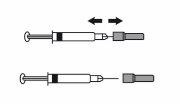
- When the amount of medication in the syringe matches the prescribed dose, there is no need to adjust the dose. You are now ready to administer the injection.
- When the dose depends on your body weight, you may need to adjust the dose in the syringe to match the prescribed dose. In this case, you can get rid of excess medication by keeping the syringe pointing downwards (to keep the air bubble in the syringe) and expelling the excess into a container.
- A drop may appear at the tip of the needle. If this happens, you must eliminate the drop before administering the injection by gently tapping the syringe with the needle pointing downwards. You are now ready to administer the injection.
Administering the injection
- Hold the syringe with the hand you write with (as if it were a pencil). With the other hand, gently pinch the area you cleaned on your stomach, between your index finger and thumb, to form a fold in the skin.
Make sure to hold this skin fold while the injection lasts.
- Maintain the syringe so that the needle points straight down (vertically at a 90-degree angle). Insert the entire needle into the skin fold.
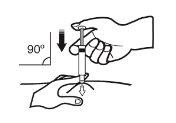
- Press the plunger with your thumb. This will administer the medication into the fatty tissue of your stomach. Complete the injection using all the medication in the syringe.
- Remove the needle from the injection site by pulling it straight out. Keep the needle away from yourself and others. You can now release the skin fold.
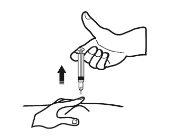
When you have finished
- To avoid bruising, do not rub the injection site after injecting.
- Place the used syringe in the container for sharp objects. Close the container lid tightly and keep it out of the reach of children. When the container is full, dispose of it as your doctor or pharmacist has indicated.
The disposal of unused medication and all materials that have come into contact with it will be carried out in accordance with local regulations.
If you think the dose is too high (for example, if you have an unexpected bleeding) or too low (for example, if the dose does not seem to be working), consult your doctor or pharmacist.
Instructions for syringes with a safety device:
Preparing the injection site
- Choose an area on the right or left side of your stomach. At least 5 cm from the navel and towards either side.
Do not inject within 5 cm of your navel or around it if there are scars or bruises.
To inject, alternate the left and right sides of your stomach, depending on where the last injection was given.

- Wash your hands. Clean (do not rub) the area where you will perform the injection with a cotton swab with alcohol or with soap and water.
- Sit or lie down in a comfortable position so that you are relaxed. Make sure you can see the area where you will inject. The most suitable is on a couch, reclining chair, or in a bed with pillows.
Selecting the dose
- Carefully remove the needle cap from the syringe by pulling it. Discard the cap.
Before injecting, do not press the plunger to eliminate air bubbles. This can cause a loss of medication.
Once you have removed the cap, do not touch anything with the needle. This will ensure that the needle remains clean (sterile).
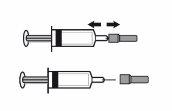
- When the amount of medication in the syringe matches the prescribed dose, there is no need to adjust the dose. You are now ready to administer the injection.
- When the dose depends on your body weight, you may need to adjust the dose in the syringe to match the prescribed dose. In this case, you can get rid of excess medication by keeping the syringe pointing downwards (to keep the air bubble in the syringe) and expelling the excess into a container.
- A drop may appear at the tip of the needle. If this happens, you must eliminate the drop before administering the injection by gently tapping the syringe with the needle pointing downwards. You are now ready to administer the injection.
Administering the injection
- Hold the syringe with the hand you write with (as if it were a pencil). With the other hand, gently pinch the area you cleaned on your stomach, between your index finger and thumb, to form a fold in the skin.
Make sure to hold this skin fold while the injection lasts.
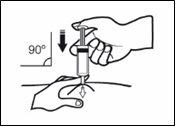 Maintain the syringe so that the needle points straight down (vertically at a 90-degree angle). Insert the entire needle into the skin fold.
Maintain the syringe so that the needle points straight down (vertically at a 90-degree angle). Insert the entire needle into the skin fold.
- Press the plunger with your thumb. This will administer the medication into the fatty tissue of your stomach. Complete the injection using all the medication in the syringe.
- Remove the needle from the injection site by pulling it straight out and keeping your finger on the plunger. Keep the needle away from yourself and others. The safety system will be activated by firmly pressing the plunger. The protective sleeve will automatically cover the needle and emit an audible click that confirms the activation of the device. You can now release the skin fold.
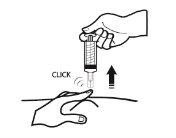
When you have finished
- To avoid bruising, do not rub the injection site after injecting.
- Place the used syringe in the container for sharp objects. Close the container lid tightly and keep it out of the reach of children. When the container is full, dispose of it as your doctor or pharmacist has indicated.
The disposal of unused medication and all materials that have come into contact with it will be carried out in accordance with local regulations.
If you think the dose is too high (for example, if you have an unexpected bleeding) or too low (for example, if the dose does not seem to be working), consult your doctor or pharmacist.
Changing anticoagulant treatment
- Changing from Enoxaparina Rovi to vitamin K antagonist medications (e.g., warfarin)
Your doctor will request a blood test to determine a parameter called INR and will tell you when to stop treatment with Enoxaparina Rovi.
- Changing from vitamin K antagonist medications (e.g., warfarin) to Enoxaparina Rovi
Stop using the vitamin K antagonist. Your doctor will request a blood test to determine a parameter called INR and will tell you when to start using Enoxaparina Rovi.
- Changing from Enoxaparina Rovi to direct oral anticoagulants
Stop using Enoxaparina Rovi. Start taking the direct oral anticoagulant 0-2 hours before the next scheduled injection, and then continue as usual.
- Changing from direct oral anticoagulants to Enoxaparina Rovi
Stop taking the direct oral anticoagulant. Do not start treatment with Enoxaparina Rovi until 12 hours have passed since the last dose of the direct oral anticoagulant.
If you use more Enoxaparina Rovi than you should
If you think you have used too much or too little Enoxaparina Rovi, inform your doctor, nurse, or pharmacist immediately, even if you do not have any signs of problems. If a child accidentally injects or swallows Enoxaparina Rovi, take them to the emergency department of a hospital immediately.
In case of overdose or accidental administration, consult your doctor or go to the emergency department of the nearest hospital, bringing this leaflet with you, or call the Toxicology Information Service, phone 91 562 04 20, indicating the medication and the amount administered.
If you forget to use Enoxaparina Rovi
If you forget to administer a dose, do so as soon as you remember. Do not use a double dose on the same day to make up for forgotten doses. To ensure you do not forget any doses, you may find it helpful to use a diary.
If you stop treatment with Enoxaparina Rovi
If you have any other doubts about using this medication, ask your doctor or pharmacist or nurse.
It is important that you continue to receive Enoxaparina Rovi until your doctor decides to stop treatment. If you stop using it, a blood clot may form, which can be very dangerous.
4. Possible Adverse Effects
Like all medicines, this medicine may cause adverse effects, although not all people suffer from them.
Like other similar medicines (medicines to reduce blood clots), Enoxaparina Rovi could cause bleeding, which could potentially put your life at risk. In some cases, the bleeding may not be evident.
If you notice any episode of bleeding that does not stop by itself or if you notice signs of excessive bleeding (unusual weakness, fatigue, paleness, dizziness, headache, or unexplained swelling), consult your doctor immediately.
Your doctor may decide to keep you under strict observation or change your medication.
Interrupt treatment with enoxaparina and inform your doctor or nurse immediately if you experience any of the following symptoms:
- Any sign of severe allergic reaction (such as difficulty breathing, swelling of lips, mouth, throat, or eyes).
- A widespread, red, and scaly rash, with bumps under the skin and blisters, accompanied by fever. The symptoms usually appear at the beginning of treatment (acute generalized exanthematous pustulosis).
You should inform your doctor immediately
- If you present any sign of a blood vessel blockage by a blood clot, such as:
- cramp-like pain, redness, heat, or swelling in one of your legs, which are symptoms of deep vein thrombosis.
- difficulty breathing, chest pain, fainting, or coughing up blood, which are symptoms of pulmonary embolism.
- If you have a painful skin rash with dark red spots under the skin that do not disappear when pressed.
Your doctor may request a blood test to check the number of platelets.
General List of Possible Adverse Effects:
Very common (may affect more than 1 in 10 people)
- Bleeding.
- Increased liver enzymes.
Common (may affect up to 1 in 10 people)
- If bruises appear more frequently than usual. This could be due to a blood problem due to a low number of platelets.
- Pink patches on the skin. They appear more frequently in the area where Enoxaparina Rovi has been injected.
- Skin rash (hives, urticaria).
- Redness and itching of the skin.
- Bruising or pain at the injection site.
- Decrease in the number of red blood cells in the blood.
- Increase in the number of platelets in the blood.
- Headache.
Uncommon (may affect up to 1 in 100 people)
- Sudden severe headache. This could be a sign of bleeding in the brain.
- Feeling of sensitivity to palpation and swelling of the stomach. It could be indicative of gastric bleeding.
- Large, red, and irregular skin lesions, with or without blisters.
- Skin irritation (local irritation).
- You may notice yellowing of the skin or eyes, and darkening of the urine color. This could be due to a liver problem.
Rare (may affect up to 1 in 1,000 people)
- Severe allergic reaction. The signs of this reaction may include: skin rash, swallowing or breathing problems, swelling of the lips, face, throat, or tongue.
- Increased potassium in the blood. This is more likely to occur in people with kidney problems or diabetes. Your doctor can check it by performing a blood test.
- Increased number of eosinophils in the blood. Your doctor can check it by performing a blood test.
- Hair loss.
- Osteoporosis (a disease in which bones can fracture more easily).
- Numbness, tingling, and weakness in the muscles (especially in the lower part of the body) when a lumbar puncture or spinal anesthesia has been performed.
- Loss of bladder or bowel control (so that you cannot control your needs).
- Hardening or nodule at the injection site.
Reporting of Adverse Effects
If you experience any type of adverse effect, consult your doctor, pharmacist, or nurse, even if it is a possible adverse effect that is not listed in this prospectus. You can also report them directly through the Spanish Pharmacovigilance System for Human Use Medicines: www.notificaRAM.es. By reporting adverse effects, you can contribute to providing more information on the safety of this medicine.
5. Conservation of Enoxaparina Rovi
Store below 25 °C. Do not freeze.
The pre-filled syringes of Enoxaparina Rovi contain a single dose; discard any unused product.
Keep this medicine out of the sight and reach of children.
Do not use this medicine after the expiration date that appears on the packaging after CAD. The expiration date is the last day of the month indicated.
Do not use this medicine if you observe that the syringe is damaged or that the product is not transparent.
Medicines should not be thrown away through wastewater or household waste. Deposit the packaging and medicines you no longer need in the SIGRE Point of the pharmacy. Ask your pharmacist how to dispose of the packaging and medicines you no longer need. This way, you will help protect the environment.
6. Package Contents and Additional Information
Composition of Enoxaparina Rovi
- The active ingredient is enoxaparin sodium.
Each pre-filled syringe contains enoxaparin sodium with anti-Xa activity of 12,000 IU (equivalent to 120 mg) in 0.8 ml of water for injectable preparations.
- The other components are water for injectable preparations.
Appearance of the Product and Package Contents
Enoxaparina Rovi is a clear, colorless to light yellow, injectable solution in a pre-filled glass syringe of type I, equipped with an injection needle, with or without an automatic safety device. It is presented as follows:
Enoxaparina Rovi 12,000 IU (120 mg)/0.8 ml injectable solution in a pre-filled graduated syringe of 1 ml.
Packaging of 10, 30, and 50 syringes.
Only some packaging sizes may be marketed.
In some packaging sizes, the pre-filled syringe may be presented combined with a safety device.
Marketing Authorization Holder and Manufacturer
Marketing Authorization Holder
Laboratorios Farmacéuticos ROVI, S.A.
Julián Camarillo, 35
28037 - Madrid, Spain
Manufacturer
ROVI Pharma Industrial Services, S.A.
Julián Camarillo, 35
28037 - Madrid, Spain
This medicine is authorized in the member states of the European Economic Area and in the United Kingdom (Northern Ireland) with the following names:
Spain: Enoxaparina Rovi
Germany: Enoxaparin Becat
Belgium: Enoxaparine Becat
Poland: Losmina
United Kingdom (Northern Ireland): Arovi
Date of the Last Revision of this Prospectus:January 2025
Other Sources of Information
Detailed information about this medicine is available on the website of the Spanish Agency for Medicines and Health Products (AEMPS) (http://www.aemps.gob.es/)

How much does ENOXAPARIN ROVI 12,000 IU (120 mg)/0.8 mL PRE-FILLED SYRINGE SOLUTION FOR INJECTION cost in Spain ( 2025)?
The average price of ENOXAPARIN ROVI 12,000 IU (120 mg)/0.8 mL PRE-FILLED SYRINGE SOLUTION FOR INJECTION in October, 2025 is around 86.05 EUR. Prices may vary depending on the region, pharmacy, and whether a prescription is required. Always check with a local pharmacy or online source for the most accurate information.
- Country of registration
- Average pharmacy price86.05 EUR
- Active substance
- Prescription requiredYes
- Manufacturer
- This information is for reference only and does not constitute medical advice. Always consult a licensed doctor before taking any medication. Oladoctor is not responsible for medical decisions based on this content.
- Alternatives to ENOXAPARIN ROVI 12,000 IU (120 mg)/0.8 mL PRE-FILLED SYRINGE SOLUTION FOR INJECTIONDosage form: INJECTABLE, 100 mg (10000 IU) enoxaparin sodium/mlActive substance: enoxaparinManufacturer: Sanofi Aventis S.A.Prescription requiredDosage form: INJECTABLE, 120 mg (12000 IU) /0.8 mlActive substance: enoxaparinManufacturer: Sanofi Aventis S.A.Prescription requiredDosage form: INJECTABLE, 150 mg (15000 IU) /1 mlActive substance: enoxaparinManufacturer: Sanofi Aventis S.A.Prescription required




